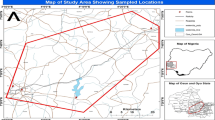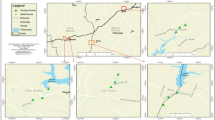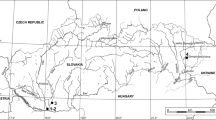Abstract
Aquatic environments, including their flora and fauna, are known reservoirs of pathogenic Vibrio species. This study aimed to determine the diversity and antimicrobial susceptibility of bacteria from water hyacinth (Eichornia crassipes) and surrounding waters in Lagos lagoons. Bacteria isolation, phenotypic, and genotypic analysis were conducted using standard microbiology and molecular methods..Sampled lagoons exhibited physicochemical parameters such as dissolved oxygen (4.76—6.91 mgL−1) and biochemical oxygen demand (80.5 – 242 mgL−1) that exceeded permissible levels, indicating pollution. A total of 41 bacterial isolates were recovered from water hyacinth samples and surrounding lagoon waters. Twelve (29.26%) were Vibrio strains, comprising 4 (9.8%) Vibrio cholerae, 3 (7.3%) V. paracholerae, 2 (4.9%) V. parahaemolyticus, 2 (4.88%) V. injensis and 1 (2.4%) V. mimicus. Of the 4 V. cholerae isolates, 1 belonged to the O1 serotype. Vibrio species were exclusively recovered from water samples. Phylogenetic analysis of the Vibrio strains isolated from different lagoons showed genetic relatedness. All 41(100%) bacteria isolates displayed pan sensitivity to meropenem, while the highest resistance rate 27(65.9%) was recorded for amoxicillin + clavulanic acid. Multiple antibiotic resistance index of 8/12 (66.7%) of multidrug resistant Vibrio isolates was > 0.2 (20%) which could imply a high risk source of contamination in the environment where they were isolated. tdh, trh, and t1 genes were detected in V. parahaemolyticus isolates. Although, water hyacinth in this study did not harbored Vibrio species, the lagoon remains a source of pathogenic drug resistant Vibrio species. Therefore, surveillance should be enhanced.





Similar content being viewed by others
Data availability
Partial 16S rRNA gene sequences generated and analysed in this study are deposited in the Genebank database under the accession numbers stated in this article. Zones of inhibition of antibiotics susceptibility testing and gel images of amplified virulence genes are available as supplementary files.
Abbreviations
- API:
-
Analytic Profile Index
- APW:
-
Alkaline Peptone Water
- BOD:
-
Biochemical Oxygen Demand
- COD:
-
Chemical Oxygen Demand
- DO:
-
Dissolved Oxygen
- MARI:
-
Multiple Antibiotic Resistance Index
- MEGA:
-
Molecular Evolutionary Genetics Analysis
- NaCl:
-
Sodium Chloride
- NTU:
-
Nephelometric Turbidity Unit
- PCR:
-
Polymerase Chain Reaction
- PSU:
-
Practical Salinity Unit
- TCBS:
-
Thiosulphate-Citrate-Bile Salt Sucrose Agar
- TDS:
-
Total Dissolved Solids
- UV:
-
Ultraviolet
- WHO:
-
World Health Organization
References
Adelekan BO, Ogunde OA (2012) Quality of water from dug wells and the lagoon in Lagos Nigeria and associated health risks. Sci Res Essays 7(11):1195–1211. https://doi.org/10.5897/SRE11.1045
Adeleye A, Enyinnia V, Nwanze R, Smith S, Omonigbehin E (2008) Antimicrobial susceptibility of potentially pathogenic halophilic Vibrio species isolated from seafoods in Lagos. Nigeria Afr J Biotechnol 7(20):3791–3794
Adeleye IA, Daniels FV, Enyinnia VA (2010) Characterization and Pathogenicity of Vibrio Spp. Contaminating Seafoods In Lagos. Nigeria Internet J Food Saf 12:1–9
Adesuyi AA, Nnodu VC, Njoku KL, Jolaoso A (2015) Nitrate and phosphate pollution in surface water of nwaja creek, port harcourt, Niger Delta, Nigeria. IJGAES 3:14–20
Agwu OA (2013) Antibiotic resistance among heterotrophic bacteria in Lagos Lagoon. Nigeria Afri J Aquatic Sci 38(3):331–336. https://doi.org/10.2989/16085914.2013.806886
Ajayi A, Smith S (2018) Recurrent cholera epidemics in Africa: which way forward? A literature review. Infection 47(3):341–349. https://doi.org/10.1007/s15010-018-1186-5
Akande-Sholabi W, Oyesiji E (2023) Antimicrobial stewardship: knowledge, perceptions, and factors associated with antibiotics misuse among consumer’s visiting the community pharmacies in a Nigeria Southwestern State. J Pharm Policy Pract 16:120. https://doi.org/10.1186/s40545-023-00629-x
APHA (1998) Standards methods for examination of wastewater. 18th edition. American public health association Washington, DC., pp 45–60
Armstrong E, Yan L, Boyd KG, Wright PC, Burgess JG (2001) The symbiotic role of marine microbes on living surfaces. Hydrobiologia 461:37–40. https://doi.org/10.1023/A:1012756913566
Ayeni AO (2014) Domestic water source, sanitation and high risk of bacteriological diseases in the urban slum: case of cholera in makoko, Lagos, Nigeria. J Environ Pollut Human Health 2(1):12–15. https://doi.org/10.12691/jephh-2-1-3
Bej AK, Patterson DP, Brasher CW, Vickery MCL, Jones DD, Kaysner CA (1999) Detection of total and hemolysin-producing Vibrio parahaemolyticus in shellfish using multiplex PCR amplification of tl, tdh and trh. J Microbiol Methods 36:215–225. https://doi.org/10.1016/s0167-7012(99)00037-8
Beshiru A, Okareh OT, Okoh AI, Igbinosa EO (2020) Detection of antibiotic resistance and virulence genes of Vibrio strains isolated from ready-to-eat shrimps in Delta and Edo States, Nigeria. J Appl Microbiol 129:17–36. https://doi.org/10.1111/jam.14590
Bhanumathi R, Sabeena F, Isac SR, Shukla BN, Singh DV (2003) Molecular characterization of Vibrio cholerae O139 Bengal isolated from water and the aquatic plant Eichhornia crassipes in the River Ganga, Varanasi, India. Appl Environ Microbiol 69:2389–2394. https://doi.org/10.1128/AEM.69.4.2389-2394.2003
Cheesebrough M (2006) Staphylococcus aureus In: District laboratory practice in tropical countries. Part 2. 2nd Edition. Cambridge University Press, London, pp 157–158. www.cambridge.org/9780521676311. Accessed 15 Jul 2021
Clinical and Laboratory Standards Institute (2015) Methods for antimicrobial dilution and disk susceptibility testing of infrequently isolated or fastidious bacteria. 3rd ed. CLSI guideline M45 ISBN 1-56238-918-1. Clinical and Laboratory Standards Institute, 950 West Valley Road, Suite 2500, Wayne, Pennsylvania 19087USA, pp 56
Elenwo EL, Akankali JA (2019) Review of conventional methods of water hyacinth controls and option for niger delta region Nigeria. IJASRR 4(01):74–90
Elimian EZ, Musah A, Mezue S, Oyebanji O, Yennan S, Jinadu A, Williams N, Ogunleye A, Fall IS, Yao M, Eteng W-E, Abok P, Popoola M, Chukwuji M, Omar LH, Ekeng E, Balde T, Mamadu I, Adeyemo A, Namara G, Okudo I, Alemu W, Peter C, Ihekweazu C (2019) Descriptive epidemiology of cholera outbreak in Nigeria, January–November, 2018: implications for the global roadmap strategy. BMC Public Health 19:1264. https://doi.org/10.1186/s12889-019-7559-6
Elliot EL, Kaysner CA, Jackson L, Tamplin ML (1998) V. cholerae, V. parahaemolyticus, V. vulnificus, and other Vibrio spp. In Food and Drug Administration Bacteriological Analytical Manual, 8th ed. (revision A), (CD-ROM version). In: RL Merker (Ed.) AOAC International, Gaithersburg, MD, pp 9.01–9.27
Emmanuel OT (2021) Study on the balance of phosphate and nitrate concentrations in the Lagos lagoon’s water system. AJENSR 4(1):14–44
EUCAST (2021) The European Committee on Antimicrobial Susceptibility Testing. Break point tables for interpretation of MICs and zone diameters version 11.0. http://www.eucast.org. Accessed 10 Jul 2021
Euzéby JP (1997) List of bacterial names with standing in nomenclature: a folder available on the Internet. Int J Syst Bacteriol 47:590–592. https://doi.org/10.1099/00207713-47-2-590
Falbo V, Carattoli A, Tosini F, Pezzella C, Dionisi AM, Luzzi I (1999) Antibiotic resistance conferred by a conjugative plasmid and a class I integron in Vibrio cholerae O1 El Tor strains isolated in Albania and Italy. Antimicrob Agents Chemoth 43:693–696. https://doi.org/10.1128/AAC.43.3.693
Farmer JJ, Janda JM, Brenner FW, Cameron DN, Birkhead KM (2005) Genus 1. Vibrio Pacini 1854, 411AL. In Bergey’s Manual of Systematic Bacteriology, 2nd ed.; The Proteobacteria Part B The Gammaproteobacteria ed. In: Brenner DJ, Krieg NR, Staley JT (eds.) Springer: New York, NY, USA, 2, pp 494–546
Federal Ministries of Agriculture, Environment and Health (2017) Antimicrobial use and resistance in Nigeria: Situation analysis and recommendation, pp 76–77. https://ncdc.gov.ng/themes/common/docs/protocols/56_1510840387.pdf. Accessed 28 March 2024
Feikin DR, Tabu CW, Gichuki J (2010) Short report: does water hyacinth on east african lakes promote cholera outbreaks? Am J Trop Med Hyg 83(2):370–373. https://doi.org/10.4269/ajtmh.2010.09-0645
Gbadegesin OA, Akintola SO (2020) A legal approach to winning the ‘Wash’ War in Nigeria. Eur J Environ Public Health 4(2):0043. https://doi.org/10.29333/ejeph/8237
Gennari M, Ghidini V, Caburlotto G, Lleo MM (2012) Virulence genes and pathogenicity islands in environmental Vibrio strains non-pathogenic to humans. Microbiol Ecol 82:563–573. https://doi.org/10.1111/j.1574-6941.2012.01427.x
Goel AK, Ponmariappan S, Kamboj DV, Singh L (2007) Single multiplex polymerase chain reaction for environmental surveillance of toxigenic-pathogenic O1 and non-O1 Vibrio cholerae. Folia Microbiol (praha) 52:81–85. https://doi.org/10.1007/BF02932143
Hall TA (1999) BioEdit: a user-friendly biological sequence alignment editor and analysis program for windows 95/98/NT. Nucleic Acids Symp Ser 41:95–98
Hatosy SM, Martiny AC (2015) The ocean as a global reservoir of antibiotic resistance genes. Appl Environ Microbiol 81:7593–7599. https://doi.org/10.1128/AEM.00736-15
He D, Ren L, Wu QL (2014) Contrasting diversity of epibiotic bacteria and surrounding bacterioplankton of a common submerged macrophyte, Potamogeton crispus, in freshwater lakes. FEMS Microbiol Ecol 90(3):551–562. https://doi.org/10.1111/1574-6941.12414
Hossain ZZ, Leekitcharoenphon P, Dalsgaard A, Sultan R, Begum A, Jensen PKM, Hendriksen RS (2018) Comparative genomics of Vibrio cholerae O1 isolated from cholera patients in Bangladesh. Lett Appl Microbiol 67(4):329–336. https://doi.org/10.1111/lam.13046
Huq A, Sack RB, Nizam A, Longini IM, Nair GB, Ali A, Morris JG Jr, Khan MNH, Siddique AK, Yunus M, Albert MJ, Sack DA, Colwell RR (2005) Critical factors influencing the occurrence of Vibrio cholerae in the environment of Bangladesh. Appl Environ Microbiol 71:645–4654. https://doi.org/10.1128/AEM.71.8.4645-4654.2005
Igbinosa O (2015) Detection and Antimicrobial Resistance of Vibrio Isolates in Aquaculture Environments: Implications for Public Health. Microb Drug Resist 22(3):238–245. https://doi.org/10.1089/mdr.2015.0169
Igbinosa EO, Okoh AI (2010) Vibrio fluvialis. An unusual enteric pathogen of increasing public health concern. Int J Environ Res Public Health 7:3628–3643. https://doi.org/10.3390/ijerph7103628
Islam SM, Zaman MH, Islam MS, Ahmed N, Clemens JD (2020) Environmental reservoirs of Vibrio cholerae. Vaccine 32(Supl 1):A52–A62. https://doi.org/10.1016/j.vaccine.2019.06.033
Islam MT, Nasreen T, Kirchberger PC, Liang KYH, Orata FD, Johura F-T, Hussain NAS, Im MS, Tarr CL, Alam M, Boucher YF (2021) Population analysis of Vibrio cholerae in aquatic reservoirs reveals a novel sister species (Vibrio paracholerae sp. nov.) with a history of association with humans. Appl Environ Microbiol 87:e00422-e521. https://doi.org/10.1128/AEM.00422-21
Iwanaga M, Toma C, Miyazato T, Insisiengmay S, Nakasone N, Ehara M (2004) Antibiotic resistance conferred by a class I integron and SXT constin in Vibrio cholerae O1 strains isolated in Laos. Antimicrob Agents Chemoth 48:2364–2369. https://doi.org/10.1128/AAC.48.7.2364-2369.2004
Janda JM, Newton AE, Bopp CA (2015) Vibriosis. Clin Lab Med 35(2):273–288. https://doi.org/10.1016/j.cll.2015.02.007
Kalpy JC, Sabine VN, Aboubakar DS, Lydie NA, Allico JD, Mady N, Mireille D (2020) Resistance profile of vibrio spp. strains collected from Lagoon Bays and Wastewater in the city of Abidjan, Côte d’Ivoire, from January to June 2017. The Open Microbiol J 14:303. https://doi.org/10.2174/1874434602014010297
Kim SM, Jun LJ, Shin SB, Park MA, Jung SH, Kim K, Moon KH, Jeong HD (2010) Mutations in the gyrB, parC, and parE Genes of Quinolone-Resistant Isolates and Mutants of Edwardsiella tarda. J Microbiol Biotechnol 20(12):1735–1743
Kim M, Kwon TH, Jung SM, Cho SH, Jin SY, Park NH (2013) Antibiotic resistance of bacteria isolated from the internal organs of edible snow crabs. PLoS ONE 8:70887. https://doi.org/10.1371/journal.pone.0070887
Kumarage PM, De Silva LADS, Heo G (2022) Aquatic environments: A potential source of antimicrobial-resistant Vibrio spp. J Appl Microbiol 00:1–13. https://doi.org/10.1111/jam.15702
Lawson EO (2011) Physico-chemical parameters and heavy metal contents of water from the mangrove swamps of Lagos Lagoon, Lagos. Nigeria. Adv Biol Res 5(1):08–21 (https://api.semanticscholar.org/CorpusID:1267059)
Laxminarayan R (2022) The overlooked pandemic of antimicrobial resistance. Lancet 399(10325):606–607. https://doi.org/10.1016/S0140-6736(21)02446-6
Mackintosh G, Colvin C (2003) Failure of rural schemes in South Africa to provide potable water. Environ Geol 44:101–105. https://doi.org/10.1007/s00254-002-0704-y
Maiti B, Shekar M, Khushiramani R, Karunasagar I, Karunasagar I (2009) Evaluation of RAPD-PCR and protein profile analysis to differentiate Vibrio harveyi strains prevalent along the southwest coast of India. J Genet 88(3):273–279. https://doi.org/10.1007/s12041-009-0040-z
Marti E, Variatza E, Balcazar JL (2014) The role of aquatic ecosystems as reservoirs of antibiotic resistance. Trends in Microbiol 22(1):36–41. https://doi.org/10.1016/j.tim.2013.11.001
Munita JM, Arias CA (2016) Mechanisms of antibiotic resistance. Microbiol Spectr 4(2). https://doi.org/10.1128/microbiolspec.VMBF-0016-2015
Nwabueze CJ, Sogbanmu TO, Ugwumba AAA (2020) Physicochemical characteristics, animal species diversity and oxidative stress responses in dominant fish from an impacted site on the Lagos lagoon. Nigeria Ife Journal of Science 22(2):081–093. https://doi.org/10.4314/ijs.v22i2.8
Obi CC, Adebusoye SA, Ugoji EO, Ilori MO, Amund OO, Hickey WJ (2016) Microbial communities in sediments of lagos lagoon, nigeria: elucidation of community structure and potential impacts of contamination by municipal and industrial wastes. Front Microbiol 7:1213. https://doi.org/10.3389/fmicb.2016.01213
Odjadjare EEO, Igbinosa O (2017) Multidrug-resistant Vibrio species isolated from abattoir effluents in Nigeria. J Infect Dev Ctries 11(5):373–378. https://doi.org/10.3855/jidc.8097
Okoh AI, Igbinosa EO (2010) Research article Antibiotic susceptibility profiles of some Vibrio strains isolated from wastewater final effluents in a rural community of the Eastern Cape Province of South Africa. BMC Microbiol 10:143. https://doi.org/10.1186/1471-2180-10-143
Oli AN, Ogbuagu VI, Ejikeugwu CP, Iroha IR, Ugwu MC, Ofomata CM, Okeke KN, Emechebe GO, Okoro JC, Okani CO, Onah SK (2019) Multi-antibiotic resistance and factors affecting carriage of extended spectrum β-lactamase-producing enterobacteriaceae in pediatric population of enugu metropolis. Nigeria Med Sci 7:104. https://doi.org/10.3390/medsci7110104
Opadokun IO, Falaye AE, Ajani EK (2015) Seasonal variation in physicochemical parameters of Lekki Lagoon and the conservation of its ecosystem. J Geosci Environ Prot 3:11–17. https://doi.org/10.4236/gep.2015.39002
Osunla CA, Okoh AI (2017) Vibrio Pathogens: A Public Health Concern in Rural Water Resources in Sub-Saharan Africa. Int J Environ Res Public Health 14(10):11888. https://doi.org/10.3390/ijerph14101188
Oyelade AA, Adelowo OO, Fagade OE (2018) blaNDM-1-producing Vibrio parahaemolyticus and V. vulnificus isolated from recreational beaches in Lagos. Nigeria Environ Sci Pollut Res 25:33538–33547. https://doi.org/10.1007/s11356-018-3306-2
Oyeleke PO, Popoola SO, Abiodun OA (2019) Assessment of some physicochemical parameters of Lagos lagoons. Southwest Nigeria. Academic J Chem 4(3):09–11. https://doi.org/10.32861/ajc.43.09.11
Ozochi CA, Nwankwo CEI, Enemuor SC, Chidebelu PE, Adukwu EC, Chigor VN (2023) Variation in bacteriological and physicochemical water quality characteristics of Asata river, Enugu, Nigeria. Microbiol J 13:1–10. https://doi.org/10.3923/mj.2023.1.10
Raghunath P (2015) Role of thermostable direct haemolysin (TDH) and TDH- related haemolysin (TRH) in Vibrio parahaemolyticus. Front Microbiol 5(805):1–4. https://doi.org/10.3389/fmicb.2014.00805
Rehm C, Lippert K, Indra A, Kolarevi S, Kračun-Kolarevi M, Leopold M, Steinbacher S, Schachner I, Campostrini L, Risslegger A, Farnleitner AH, Kolm C, Kirschner AKT (2023) First report on the occurrence of Vibrio choleraenonO1/nonO139 in natural and artificial lakes and ponds in Serbia: Evidence for a long-distance transfer of strains and the presence of Vibrio paracholerae. Environ Microbiol Rep 15(2):142–152. https://doi.org/10.1111/1758-2229.13136
Schmidt AS, Bruun MS, Dalsgaard I, Larsen JL (2001) Incidence, distribution, and spread of tetracycline resistance determinants and integronassociated antibiotic resistance genes among motile aeromonads from a fish farming environment. Appl Environ Microbiol 67:5675–5682. https://doi.org/10.1128/AEM.67.12.5675-5682.2001
Sikorski MJ, Levine MM (2020) Reviving the “Moore swab”: a classic environmental surveillance tool involving filtration of flowing surface water and sewage water to recover typhoidal Salmonella bacteria. Appl Environ Microbiol 86:e00060-e120. https://doi.org/10.1128/AEM.00060-20
Singh DV, Matte MH, Matte GR, Jiang S, Sabeena F, Shukla BN (2001) Molecular analysis of Vibrio cholerae O1, O139, non-O1, and non-O139 strains: clonal relationships between clinical and environmental isolates. Appl Environ Microbiol 67:910–921. https://doi.org/10.1128/AEM.67.2.910-921.2001
Singh AK, Kaur R, Verma S, Singh S (2022) Antimicrobials and Antibiotic Resistance Genes in Water Bodies: Pollution, Risk, and Control. Front Environ Sci 10:830861. https://doi.org/10.3389/fenvs.2022.830861
Sogbanmu TO, Ogunkoya OA, Olaniran EI, Lasisi AK, Seiler TB (2021) Adverse impact of human activities on aquatic ecosystems: investigating the environmental sustainability perception of stakeholders in Lagos and Ogun States, Nigeria. In: Nubi TG, Anderson I, Lawanson T, Oyalowo B (eds) Housing and SDGs in Urban Africa. Advances in 21st Century Human Settlements. Springer, Singapore. https://doi.org/10.1007/978-981-33-4424-2_7
Tamura K, Stecher G, Kumar S (2021) MEGA11: Molecular evolutionary genetics analysis version 11. Mol Biol Evol 38(7):3022–3027. https://doi.org/10.1093/molbev/msab120
Tarr CL, Patel JS, Puhr ND, Sowers EG, Bopp CA, Strockbine NA (2007) Identification of Vibrio isolates by a multiplex PCR assay and rpoB sequence determination. J Clin Microbiol 45(1):134–140. https://doi.org/10.1128/JCM.01544-06
Thompson JR, Polz MF (2006) Dynamics of Vibrio populations and their role in environmental nutrient cycling. In: Thompson FL, Austin B, Swings J (eds) The Biology of Vibrios. ASM Press, Washington, DC, USA, pp 190–203
Uka UN, Chukwuka KS, Daddy F (2007) Water hyacinth infestation and management in Nigeria inland waters. A Review J Plant Sci 2(5):480–488. https://doi.org/10.3923/jps.2007.480.488
WHO (2004) Guidelines for drinking water quality, Third Edition. Volume 1: Recommendations. World Health Organization, Geneva
Zhang X-H, Austin B (2005) Haemolysins in Vibrio species. J Appl Microbiol 98:1011–1019. https://doi.org/10.1111/j.1365-2672.2005.02583.x
Funding
The authors did not receive any financial support for the research.
Author information
Authors and Affiliations
Contributions
KBW: Sample collection, investigation, data analysis, UUE: Investigation, data analysis. Abraham Ajayi: Conceptualization, investigation, data analysis, writing of original draft. GA: Investigation, data analysis. DKO: Data analysis, Writing – review & editing.
AIA: Conceptualization, Supervision, writing – review & editing. SIS: Conceptualization, Supervision, Writing – review & editing.
Corresponding author
Ethics declarations
Ethical approval
Not applicable.
Consent to participate
Not applicable.
Consent for publication
Not applicable.
Conflict of interest
All authors have no conflict of interest.
Additional information
Publisher's Note
Springer Nature remains neutral with regard to jurisdictional claims in published maps and institutional affiliations.
Supplementary Information
Below is the link to the electronic supplementary material.
Rights and permissions
Springer Nature or its licensor (e.g. a society or other partner) holds exclusive rights to this article under a publishing agreement with the author(s) or other rightsholder(s); author self-archiving of the accepted manuscript version of this article is solely governed by the terms of such publishing agreement and applicable law.
About this article
Cite this article
Wali, K.B., Essiet, U.U., Ajayi, A. et al. Molecular diversity and antimicrobial susceptibility profile of Vibrio species and distribution of other bacteria isolated from water Hyacinth (Eichornia crassipes) and Lagos lagoon. Biologia (2024). https://doi.org/10.1007/s11756-024-01697-3
Received:
Accepted:
Published:
DOI: https://doi.org/10.1007/s11756-024-01697-3




